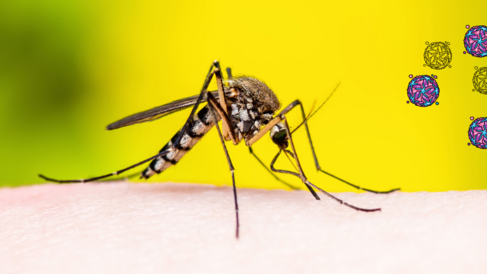
The yellow fever mosquito (Aedes aegypti) has evolved to become an efficient vector for arboviruses (i.e. any virus that is transmitted byarthropods (insects) such as mosquitoes and ticks), but the mechanisms of host-pathogen tolerance are unknown.
Insect Toll receptors, which perform critical functions in innate immunity, are activated by a family of six cytokine-like molecules called Spaetzle (Spz). The Gangloff group and collaborators have now used purified proteins to characterise the Toll5A-Spz1C interactions predicted to mediate immune functions in mosquitoes. Cryo-EM and biophysical studies reveal transient interactions between Toll5A and Spz1C, which reversibly assemble into asymmetric complexes to promote signalling. In contrast, unbound Toll5A receptors are kept in an inactive conformation. The findings in this recent study thus explain how upregulation of Spz1C in the midgut and Toll5A in the salivary gland shape the concomitant immune response.
Publication details:
Structure and dynamics of Toll immunoreceptor activation in the mosquito Aedes aegypti
Yoann Saucereau, Thomas H. Wilson, Matthew C. K. Tang, Martin C. Moncrieffe, Steven W. Hardwick, Dimitri Y. Chirgadze, Sandro G. Soares, Maria Jose Marcaida, Nicholas J. Gay & Monique Gangloff
Nature Communicationsvolume 13, Article number: 5110 (2022)
Aedes aegypti has evolved to become an efficient vector for arboviruses but the mechanisms of host-pathogen tolerance are unknown. Immunoreceptor Toll and its ligand Spaetzle have undergone duplication which may allow neofunctionalization and adaptation. Here we present cryo-EM structures and biophysical characterisation of low affinity Toll5A complexes that display transient but specific interactions with Spaetzle1C, forming asymmetric complexes, with only one ligand clearly resolved. Loop structures of Spaetzle1C and Toll5A intercalate, temporarily bridging the receptor C-termini to promote signalling. By contrast unbound receptors form head-to-head homodimers that keep the juxtamembrane regions far apart in an inactive conformation. Interestingly the transcriptional signature of Spaetzle1C differs from other Spaetzle cytokines and controls genes involved in innate immunity, metabolism and tissue regeneration. Taken together our results explain how upregulation of Spaetzle1C in the midgut and Toll5A in the salivary gland shape the concomitant immune response.
